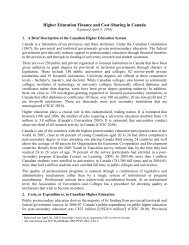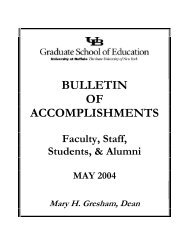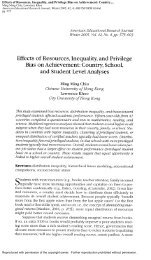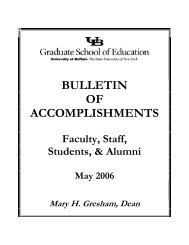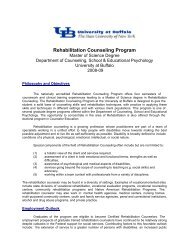Alberti Center for Bullying Abuse Prevention - UB Graduate School ...
Alberti Center for Bullying Abuse Prevention - UB Graduate School ...
Alberti Center for Bullying Abuse Prevention - UB Graduate School ...
Create successful ePaper yourself
Turn your PDF publications into a flip-book with our unique Google optimized e-Paper software.
indirect <strong>for</strong>ms. More specifically, bullying can occur physically, verbally, through social<br />
manipulation or exclusion (relational aggression), or through electronic means such as a<br />
computer or cell phone, known as cyberbullying. 2-4 <strong>Bullying</strong> impacts individuals across<br />
gender, age, and nationality, 2,5 although it tends to peak in middle school. 6 Studies have<br />
indicated that, across grade levels, approximately one in five children and adolescents are<br />
victims of bullying, 7 and 32% of middle and high school students report bullying others or<br />
being the victims of bullying. 8<br />
<strong>Bullying</strong> can lead to negative outcomes <strong>for</strong> victims, including depression, withdrawal,<br />
loneliness, truancy, school dropout, and suicidal ideation. 9-11 Youth who bully may experience<br />
externalizing problems, inadequate coping skills, academic difficulties, and interpersonal<br />
relationships problems. 12<br />
Educators are often not involved since most students do not report incidents. These incidents<br />
may not be observed or noticed by school staff since they often occur in cafeterias, hallways,<br />
and on buses. Sometimes school personnel believe that bullying is a common part of<br />
childhood, and in other cases, staff may not know how to respond. There are cases where fear<br />
of retaliation from the student who bullies is prevalent. Research suggests that bullying is more<br />
likely to thrive in school environments where adults ignore or dismiss it and where students<br />
are not academically engaged or socially connected. 13-15<br />
Adoption of empirically-based school-wide programs and a commitment to sustained<br />
professional development can increase the probability of reducing bullying in our schools and<br />
communities. Most successful programs are those that use multi-level interventions. 16-18<br />
Experts generally provide guidelines <strong>for</strong> schools to follow as opposed to prescribing a particular<br />
program. 19-21 Although there are variations in these guidelines, some of the common aspects to<br />
include are listed in Table 1.<br />
gse.buffalo.edu/alberticenter <br />
Toolkit <strong>for</strong> Educators <br />
5




